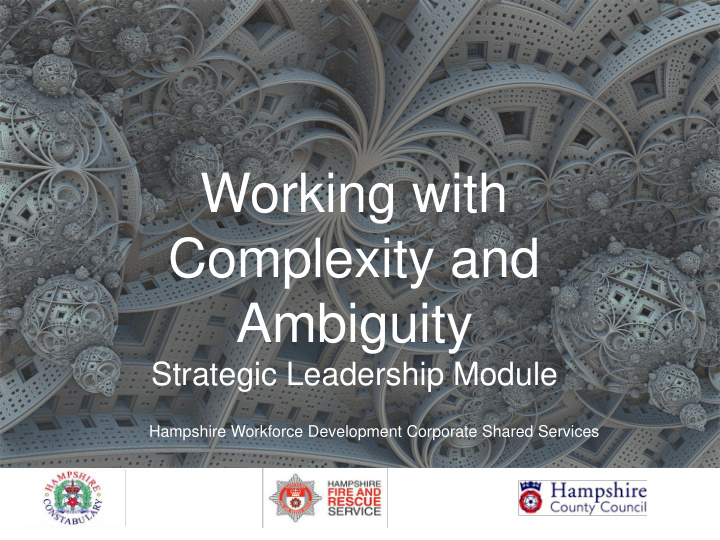



Working with Complexity and Ambiguity Strategic Leadership Module Hampshire Workforce Development Corporate Shared Services
Completing all the elements of Learning Outcomes By the end of the session you will be able to this learning will • Recognise the nature of your current enable you to complex or ambiguous challenges and apply techniques to manage them improve your • Be a role model for viewing complexity and ambiguity as positive opportunities ability to lead • Inspire, motivate and lead others when others when the the way ahead is unclear, promoting a service culture where complexity and way ahead is ambiguity are viewed as positive opportunities unclear or complex.
“The 21 st century will be the century of complexity” Stephen Hawking
• What are the biggest strategic leadership issues that you are grappling with at the moment? • How easy are they to resolve?
The mechanical mindset
The mechanical mindset • To what extent is that mindset reflected in your environment? • What kind of things do you measure and seek to predict? • What kind of hierarchy? Components? Tasks? Functions?
The mechanical mindset • Does it work for some things? • When might command and control be really useful?
Wicked issues
Going back to your list of strategic issues • Which of these issues do you and your colleagues face that just never get resolved? • That, despite your best efforts, measurements and predictions, despite your action plans and accountabilities, just keep bobbing up? • Why is that?
Interdependence and relationships
“You think because you understand one, you must understand two, because one and one makes two. But you must also understand and.” Ancient Sufi teaching.
”With relationships, we give up on predictability and open up to potentials… None of us exists independent of our relationships with others.” Margaret Wheatley
Let’s see it in action
Now let’s do it
Complex adaptive systems need simple rules Vision Principles Dialogue
Systems leadership is: • systemic – based on shared ambition. • participative – involving many people’s expertise and ideas • emergent – allows for partial / clumsy solutions • based on trust and relationships – therefore on behaviours
Infection control
Mental Health in Hampshire (1) • What would be a traditional, mechanical approach? • What would then tend to be the outcomes? • Would all those outcomes be welcome?
Unintended consequences
Mental Health in Hampshire (2) • What if we used VPD? • What would our vision and purpose be? • What values and principles would matter most? • What freedoms might people have to act? • Who would we talk to? • What information would we gather?
“The leader’s job is not to have a grand vision and show people how to reach it. The leader’s job is to frame adaptive challenges and complex contexts in ways that moblize the diverse networks of people who must change so that they will want to change.” Bushe & Marshak
Neuroscience minimising maximising threat reward
SCARF model STATUS: relative importance to others CERTAINTY: being able to predict the future AUTONOMY: sense of control over events RELATEDNESS: sense of safety with others FAIRNESS: perception of fair exchanges
Using VPD and SCARF • Groups of three. Focus on one person at a time. • One at any time to be the “owner” of a wicked issue. • The other two to coach and ask questions to stimulate thinking. • If wished, a coach may make notes on handout for the owner. • 15minutes each.
• Thoughts? • Actions? • How will you hold yourself to account?
Completing all the elements of Learning Outcomes By the end of the session you will be able to this learning will • Recognise the nature of your current enable you to complex or ambiguous challenges and apply techniques to manage them improve your • Be a role model for viewing complexity and ambiguity as positive opportunities ability to lead • Inspire, motivate and lead others when others when the the way ahead is unclear, promoting a service culture where complexity and way ahead is ambiguity are viewed as positive opportunities unclear or complex.
Further reading - books • “Leadership and the New Science” – Margaret J Wheatley • “The Fifth Discipline: The Art and Practice of the Learning Organization” – Peter Senge • “Complexity: A Very Short Introduction” – John H Holland • “Complex Adaptive Leadership: Embracing Paradox and Uncertainty” – Nick Obolensky • “The Art of Change Making “ Curated and produced by John Atkinson, Emma Loftus and John Jarvis on behalf of the Systems Leadership Steering Group, The Leadership Centre
Further reading - articles • “Want to understand how Trump happened? Study quantum physics.” – Parag Khanna • “Wicked Problems and Clumsy Solutions: the Role of Leadership” – Keith Grint • “Living Leadership” – The Leadership Centre for Local Government • “The Dialogic Mindset: Leading Emergent Change in a Complex World” – Bushe & Marshak • “SCARF: a brain -based model for collaborating with and influencing others” – David Rock (NeuroLeadership Journal) • “Systems Leadership: Exceptional leadership for exceptional times” Synthesis paper – Ghate, Lewis and Welbourn • “The Revolution will be Improvised: Stories and insights about transforming systems” – Richard Vize
Working with Complexity and Ambiguity Strategic Leadership Module Hampshire Workforce Development Corporate Shared Services
Recommend
More recommend